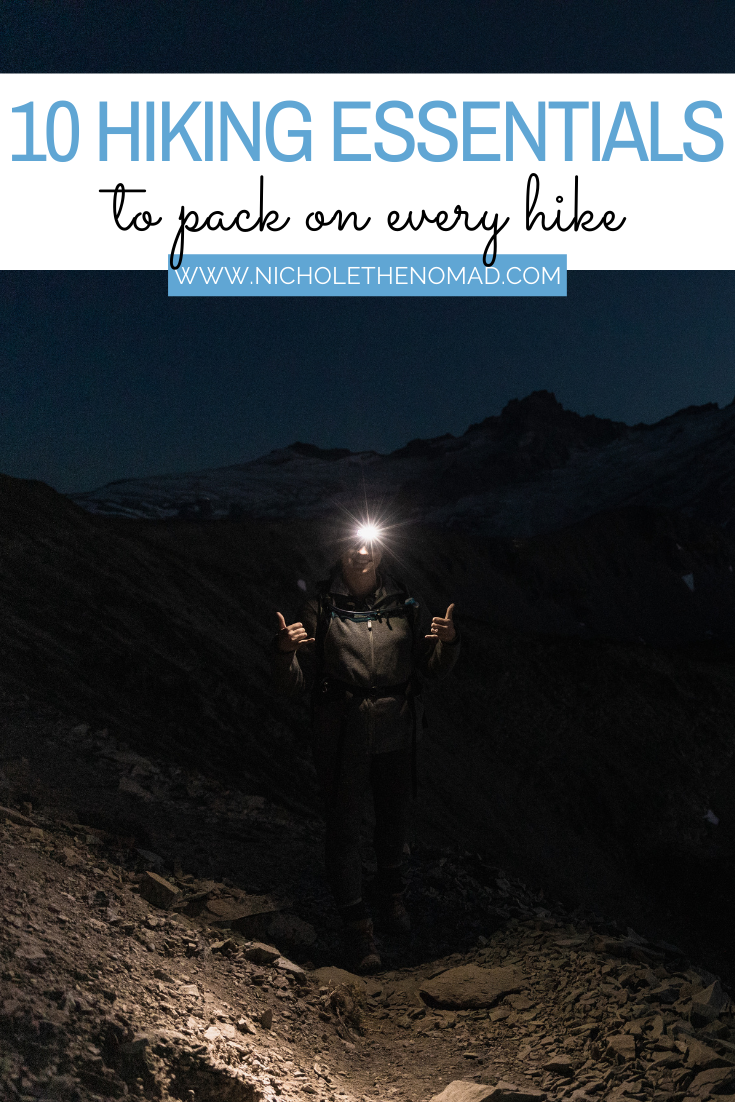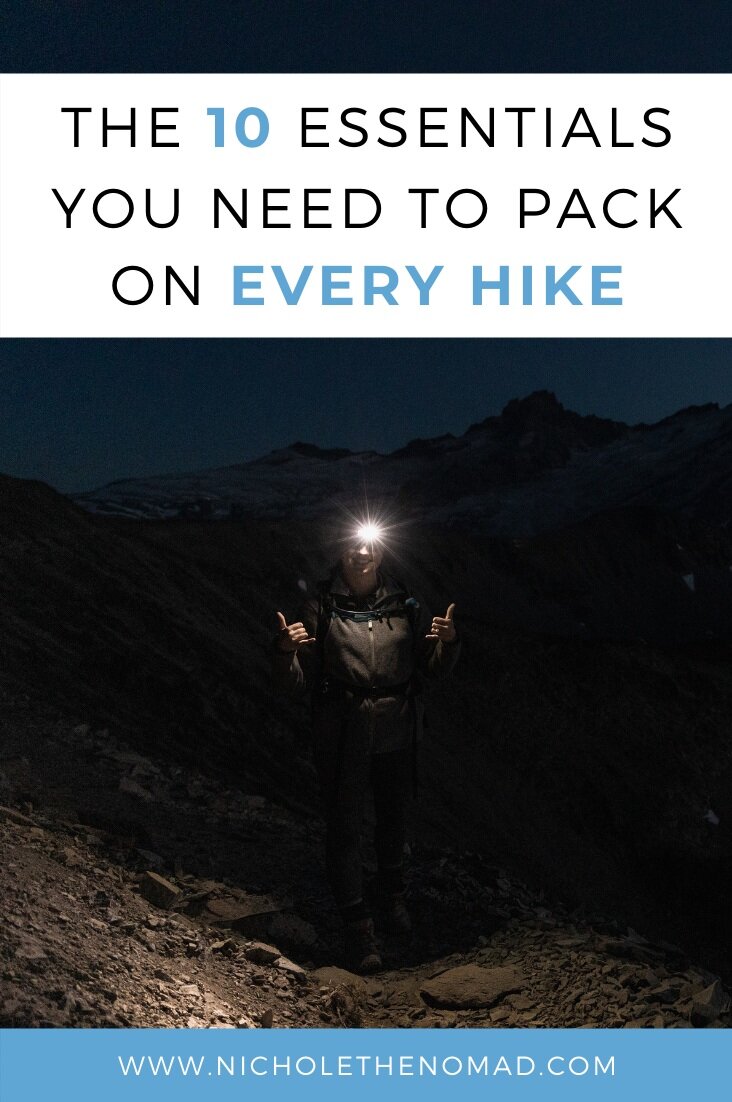The Ten Essentials: Essential Hiking Gear for Every Hike
The Ten Essentials are items that are considered essential hiking gear and should be packed for every hike. The original essential hiking gear list was created by The Mountaineers in the 1930s to help people prepare for emergencies while in the outdoors. The original essential hiking gear list included individual items and has since evolved into a systems approach with broader terms.
Packing the Ten Essentials is a great habit to get into whenever going out on a hike. One of the first Leave No Trace Principles is to be prepared, and I include having the Ten Essentials packed in that principle. Some of the items you may never use on a hike, but knowing they are there in case something goes wrong on your trip will make you feel much more prepared. This guide will go over the Ten Hiking Essentials and why they are essential hiking gear for a day hike or backpacking trip.
Disclaimer: This post contains affiliate links. If you click through and make a purchase, my blog may receive a commission at no additional cost to you.
The Ten Essentials: Essential Hiking Gear
Navigation
Having a navigation system while hiking is very important, especially when traveling in the backcountry. I always recommend having a navigation system on every hike, regardless of the length and difficulty of the trail. A few of the best navigation gear you should pack for a day hike or backpacking trip are a map, compass, GPS device, and personal locator beacon.
Map
A physical topographic map is a piece of essential hiking gear, in my opinion, when heading into the backcountry on a longer hike. Although many people choose to have a GPS device, we cannot always rely on technology, so having a map is very helpful.
Compass
A map should almost always be paired with a compass. It can be easy to feel lost in the backcountry if you make one wrong turn, so having a compass and a map to help reorient yourself is important.
GPS Device
A GPS device is a piece of essential hiking gear and can be paired with a map and compass. It is great to use in the outdoors because it is rugged and waterproof, unlike most paper maps. Many hikers like to use a GPS app on their phone, which can be great but is more vulnerable to weather conditions. If you do choose to use a GPS app, I recommend packing an external battery to ensure your phone battery does not die while you are out on the trail.
Personal Locator Beacon or Satellite Messenger
You will see almost every thru-hiker carrying a PLB while out on the trail. The PLB can be activated in an emergency and will send your coordinates to emergency personnel.
Many hikers use and love the Garmin inReach. It has an SOS button, GPS navigation, and text message capability. The Garmin inReach Explorer+ is satellite-based, allowing it to work while you are off the grid.
Illumination
Even if you are only going out on a day hike, a headlamp is a piece of essential hiking gear. It is always important to have a light source when out on the trail, especially when going on a backpacking trip. A headlamp will allow you to hike when the light starts to fade and set up camp and cook dinner easier once night falls.
Sun Protection
When you pack for a day hike or backpacking trip, it is important to have a form of sun protection to protect your skin and eyes. Wearing sunscreen or having sun-protective clothes helps prevent sunburns, and sunglasses help prevent snow blindness. I recommend wearing sunscreen, sun-protective clothing, and sunglasses on every hike, or at least packing them.
Sunscreen
Being outside in the sun all day while hiking can cause sunburns or premature skin aging. Wearing sunscreen that has at least 30 SPF will help protect your skin from long term damage.
Sun-protective Clothing
Clothing that has a UPF (ultraviolet protection factor) rating can be a great way to block UV rays. Many shirts and pants come with UPF and are great ways to protect your skin along with using sunscreen on areas the clothing does not cover. A hat is another great piece of gear that can provide sun protection.
One of the best UPF hiking shirts is the Columbia PFG Shirt. It is UPF 40, antimicrobial, breathable, and moisture-wicking.
Sunglasses
When hiking in the winter or in areas that have snow, it is crucial to have sunglasses that can protect your eyes from snow blindness. If the sun is bouncing off of the snow into your eyes, it can cause damage, such as cataracts. Sunglasses that block 100% of UVA and UVB are the best to protect your eyes.
First Aid
I always recommend bringing a first aid kit on every hike. A first aid kit is a piece of essential hiking gear for all hikes, no matter how long or difficult the trail is. The longer the hike is, the more extensive your first aid kit should have. They should all carry essential items, including bandages, disinfecting wipes, adhesive tape, and over the counter pain medication. You never know when you will need a first aid kit while hiking, even if it is for a minor cut. It is also great to pack bug repellent.
Repair Kit
It is always important to carry a repair kit while hiking. Typically, the kit will include a knife, scissors, and duct tape. A knife is a piece of essential hiking gear that should always be carried. It can be used for a variety of things, including first aid, gear repair, and any emergency. There are many different kinds of knives, but the two best are a single fold out blade or multitool knife. Either way, a small and easily packable knife works best for hiking.
Fire
Understanding how to build a fire and having the supplies to help is crucial when hiking. Matches work great as long as they are carried in a waterproof container or plastic bag. For hikers going on longer backpacking trips, having a fire starter that can sustain heat for a little bit is a great option as well.
Shelter
Packing an emergency shelter, such as a space blanket, bivvy sack, or ultralight tarp, is important for every hike. Most of the items pack down small and are very lightweight, so you will not notice they are in your hiking backpack. An emergency shelter is a great just-in-case piece of hiking gear in case you get stuck in a storm or are stranded on the trail.
Hydration
It is crucial to pack extra water on any day hike or backpacking trip. I also recommend having a water filtration system in case you need more water or will be out on the trail for a few days. Many hikers pack half a liter for every hour they will be moving in moderate temperatures. If you are hiking in warmer weather or in an area that will have a lot of altitude change, I recommend packing more water than you think you will need.
Many backpacks are compatible with hydration reservoirs, which come in various sizes and make it easy to access your water while hiking without stopping. The LifeStraw Peak Water Filter System is a piece of hiking gear to filter and store water. The Sawyer Squeeze is another great water filter.
Nutrition
Packing extra food on a hike is crucial because you never know what could happen while out on the trail that may require you to be out longer than you thought. When you pack for a day hike, it is recommended to pack an extra day’s worth of food, and for backpacking trips, it is recommended to pack more than one day’s worth of food. Packing food that does not require cooking, such as energy bars and jerky, are great options.
Some of my favorite hiking foods are:
Honey Stinger Gluten-Free Waffle - Find at REI
Bobo's Oat Bars Stuff'd Oat Bites - Find at REI
Clif Nut Butter Filled Bars - Find at REI
Mexican Quinoa Bowl - Find at Good To-Go
Insulation
It is important to pack layers and rain gear for a day hike or backpacking trip. Weather can be unpredictable, so it is crucial to be prepared. Some great items to pack are extra socks, gloves, an insulated jacket, base layer shirt and pants, and a rain jacket. If you are hiking in the winter or in an area that has colder weather, I recommend packing additional layers for your entire body. Most hiking backpacks come with a rain cover, but if yours does not, I recommend buying one to protect your backpack and all of its contents.
Whether you are going on a day hike or a multi-day backpacking trip, you should always pack the Ten Essentials. These items are essential hiking gear even though you most likely won’t have to use some of them on many of your hikes. This guide helps you understand what the Ten Hiking Essentials are and why they are essential hiking gear for a day hike or backpacking trip!
Hey, I’m Nichole!
I am the creator behind Nichole the Nomad, the home of my explorations around the world, mountain hikes, and beautiful pictures taken along the way. I have a deep passion for capturing the world in a beautiful light and sharing my experiences.
I created this blog to share my travels, show how beautiful the world is, provide tips and tricks for traveling, and encourage you to explore. Whether you want to travel across the world or explore what’s in your backyard, I hope this blog inspires you to get outside and find your adventure!
Pin it for later!









